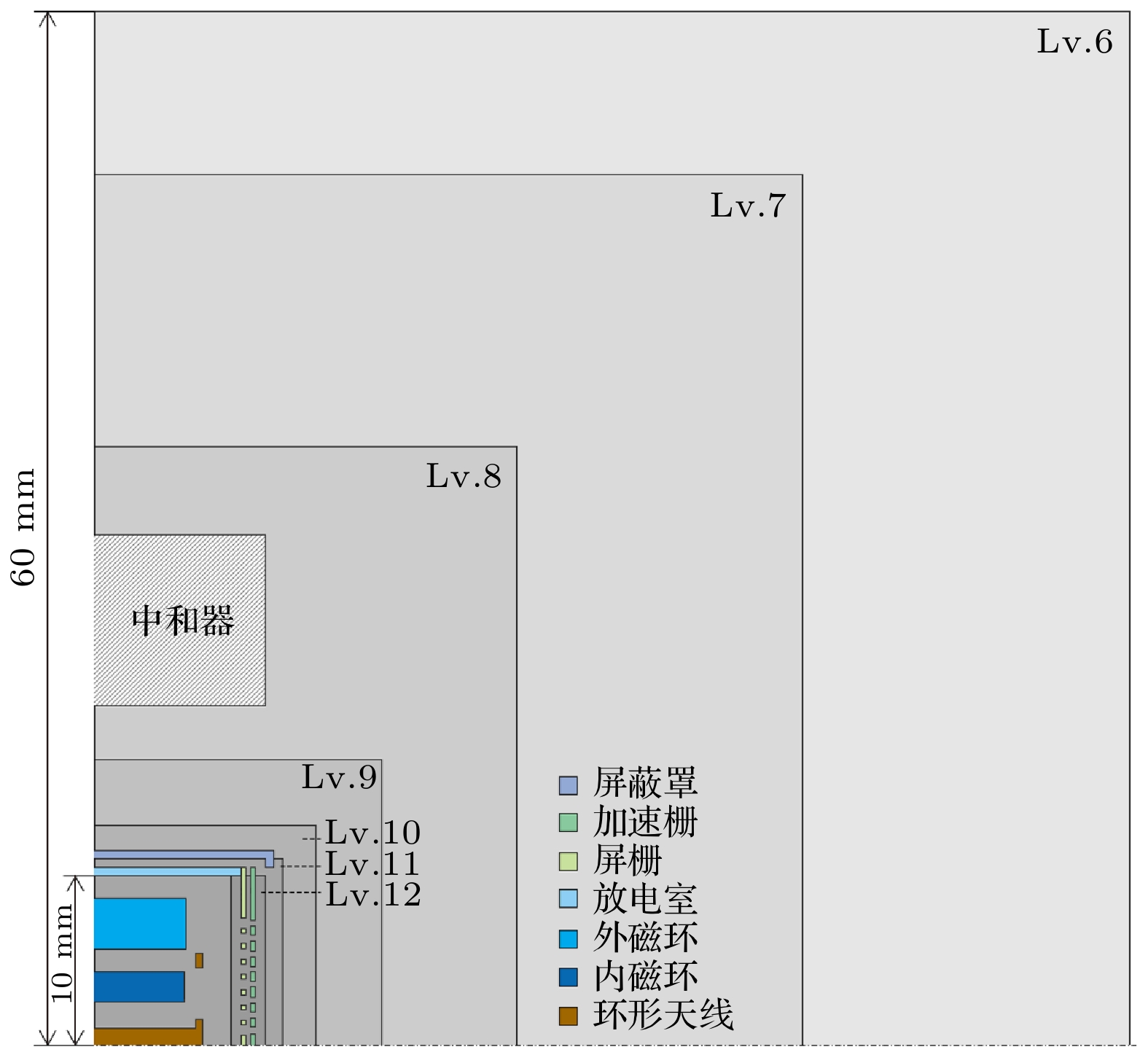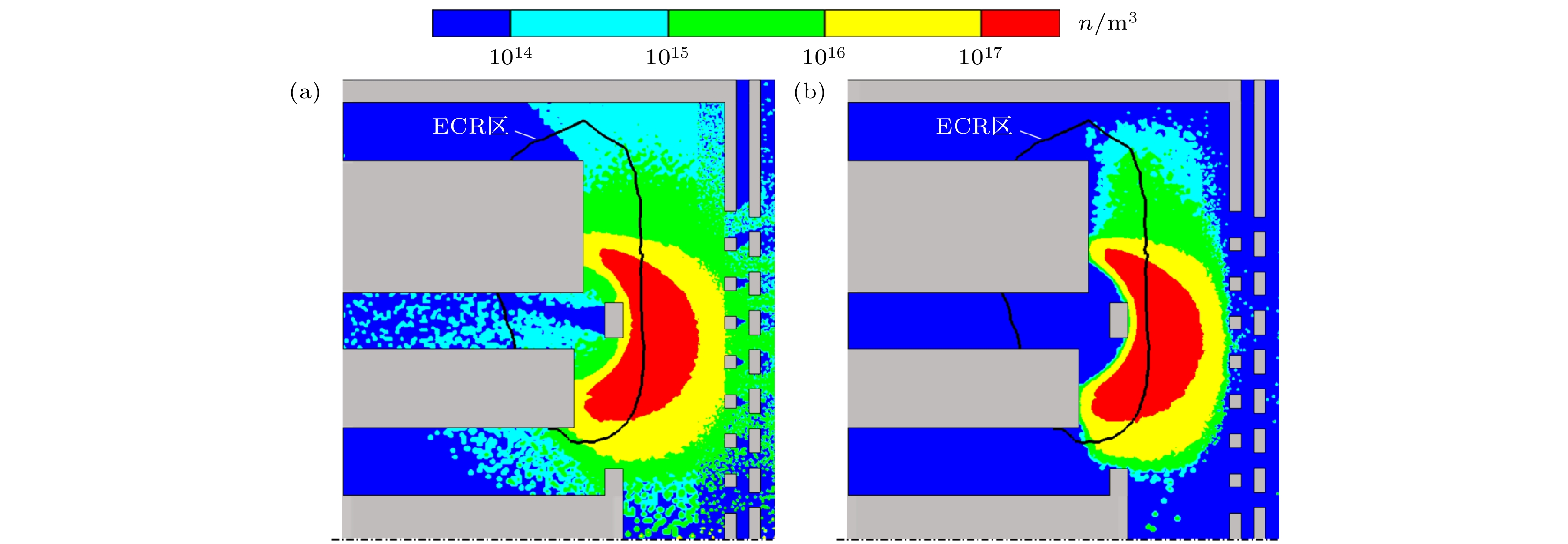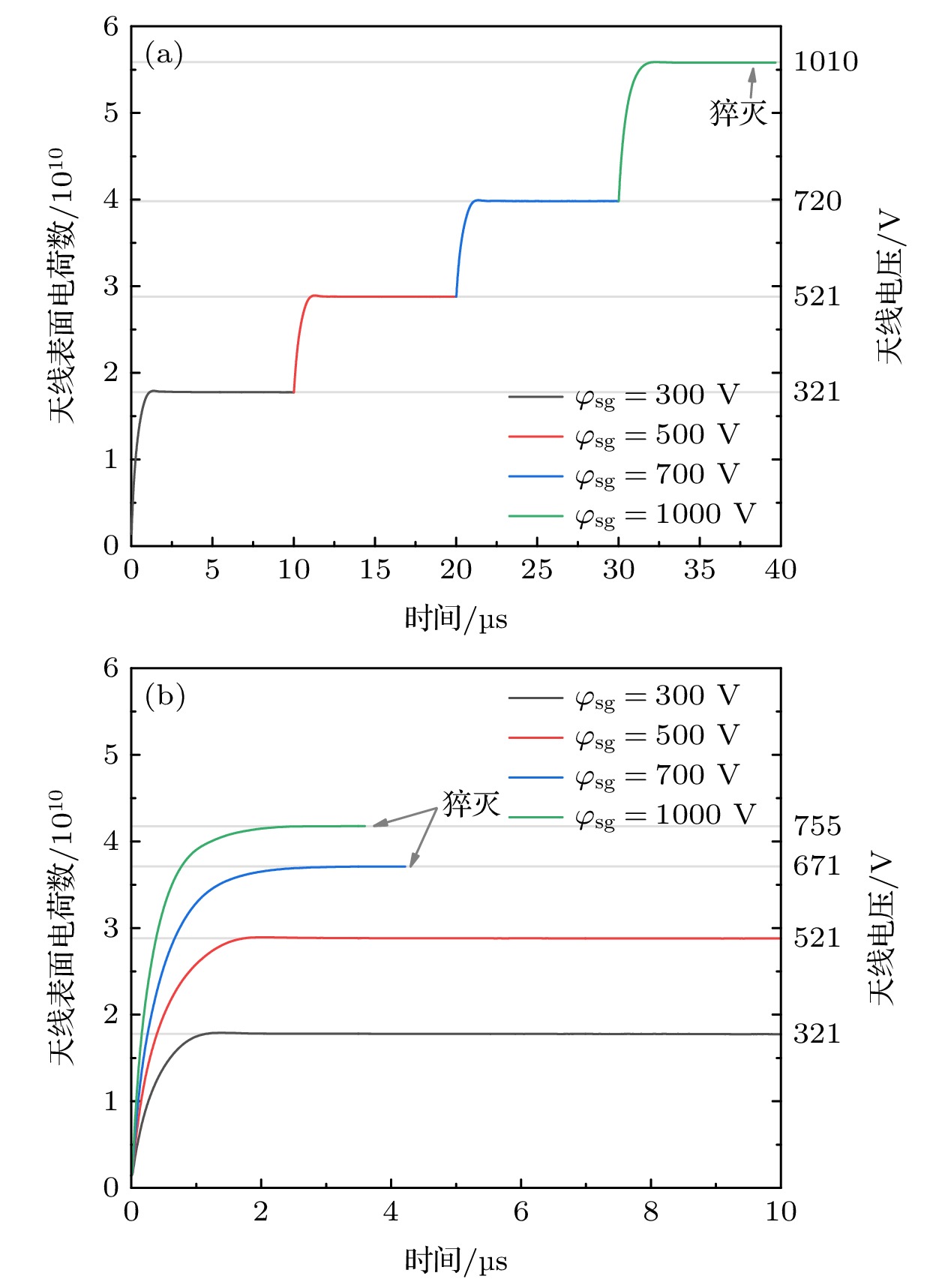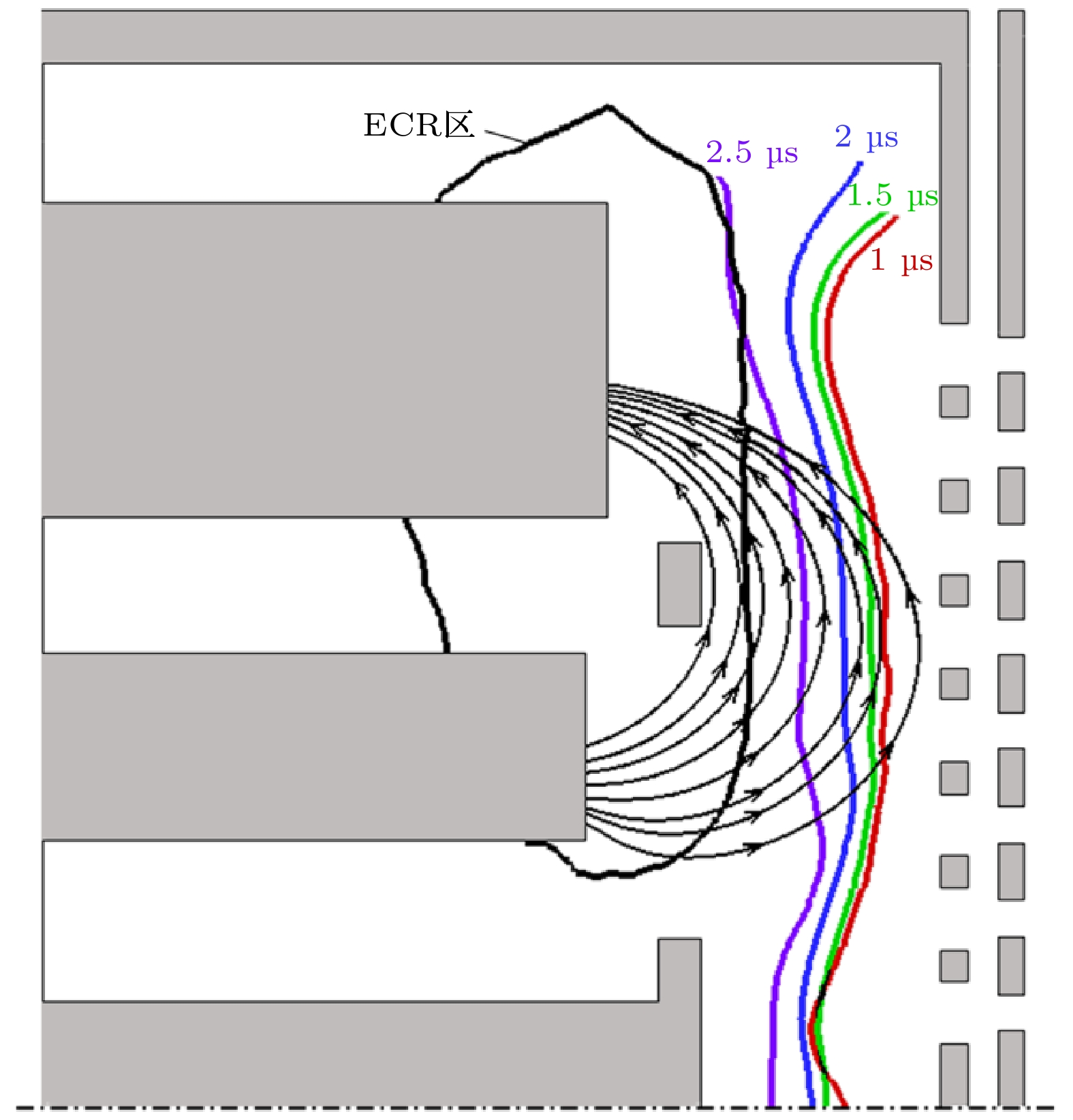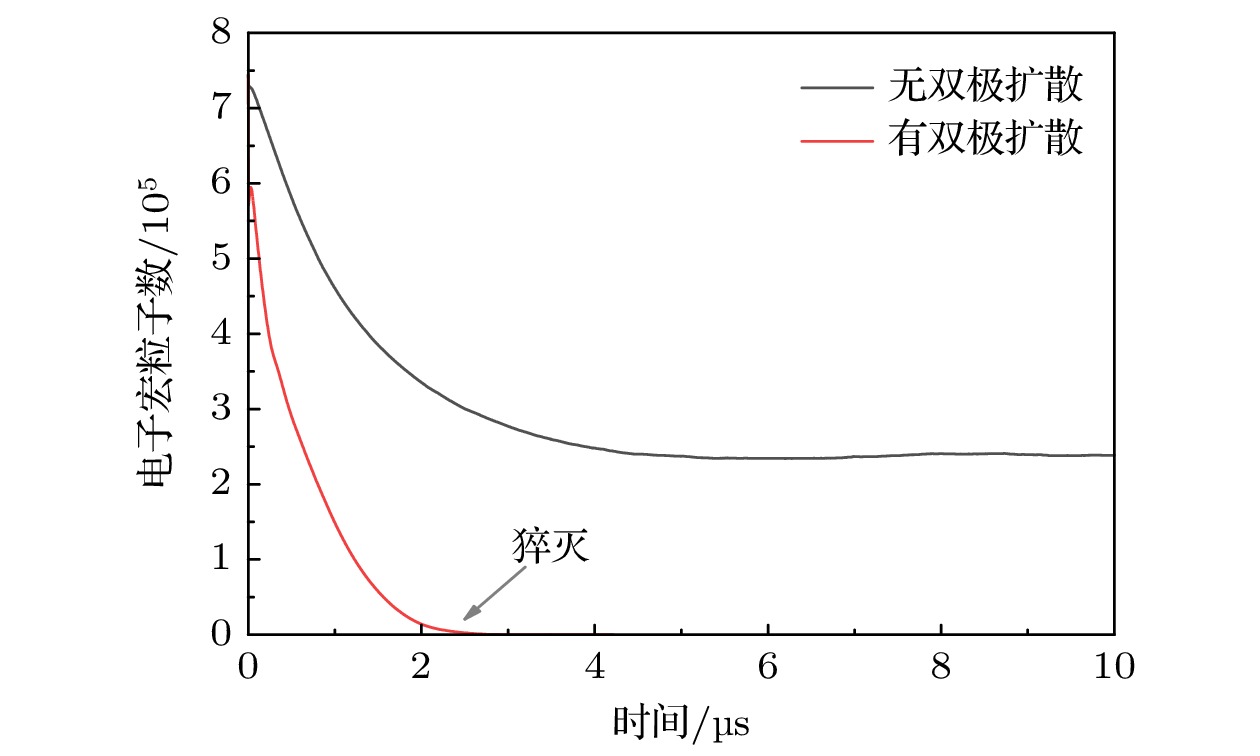-
2 cm电子回旋共振离子推力器具有高比冲、长寿命的特点, 其应用于引力波探测的可行性已经过初步探索. 然而, 在探究离子源推力下限的过程中发现, 在极低功率(0.5 W)和极低流量(0.1 sccm, 1 sccm = 1 L/min)的极限工作状态下, 过度施加栅极电压可能引发离子源猝灭. 采用实验手段对猝灭现象进行观测的难度很大, 一方面因为猝灭现象具有随机性和瞬时性; 另一方面, 介入式诊断对弱放电水平的等离子体干扰很大, 而光学诊断又有栅极系统阻挡. 为此本文采用全粒子数值模型对离子源进行了一体化模拟, 复现了猝灭现象. 模拟结果表明, 天线和放电室之间的双极扩散是导致离子源猝灭的最根本原因. 明晰了猝灭机理后, 本文提出了相应的改进措施, 并用一体化模拟进行了理论验证. 对猝灭机理的研究将为离子源的设计和应用提供理论依据, 保障离子源安全稳定工作, 满足引力波探测任务的推力需求.A 2-cm electron cyclotron resonance ion source has the advantages of long life and high specific impulse, which can meet the requirements for space gravitational waves detection. In the experiment on finding the lower limit of thrust, it is found that when the ion source operates under the extreme condition of 0.5-W microwave power and 0.1-sccm gas flow rate, increasing the voltages of grid system excessively may cause flameout. The plasma discharge level is controlled by the gas supply, microwave, and power supply system, and their small disturbances will make experimental results different, thus the flameout of the ion source appears randomly and transiently. Besides, it is difficult to observe the flameout phenomenon experimentally, because the probe diagnosis has big interference to low-density plasma, and the optical diagnosis is blocked by the grid system. Therefore, the integrative simulation with the full particle-in-cell method is used to simulate the operating process of the ion source, whose calculation range includes the discharge chamber, grid system, and plume. Through simulating the processes of plasma discharge and ion beam extraction continuously in space and time, the flameout phenomenon can be reproduced artificially after increasing the voltages of grid system. The simulation results show that the ambipolar diffusion between the antenna and discharge chamber is the fundamental reason for the flameout of the ion source. In the circuit, the antenna does not touch the discharge chamber but for bulk plasma, which makes its surface gradually accumulate charges until it reaches the floating potential. Because the increase of the voltage of antenna lags behind that of grid system, a strong electric field will appear between the antenna and chamber. Then, electrons and ions respectively move toward the chamber and antenna, the ambipolar diffusion helps the antenna reach the floating potential rapidly. When the plasma density inside the chamber is low, the ambipolar diffusion will cause flameout. In order to avoid the flameout of the ion source in such an extreme situation, an improvement measure that the voltage of antenna equals the voltage of chamber is proposed, which is verified by the integrative simulation. The study on the flameout phenomenon will provide a theoretical basis for the design and application of the ion source, which can help the ion source operate safely to meet the requirements for space gravitational wave detection.
-
Keywords:
- electron cyclotron resonance ion source /
- particle-in-cell simulation /
- flameout phenomenon
[1] Lemmer K 2017 Acta Astronaut. 134 231
 Google Scholar
Google Scholar
[2] Blanco A, Roy S 2017 J. Phys. D: Appl. Phys. 50 455201
 Google Scholar
Google Scholar
[3] Xu S Y, Xu L X, Cong L X, Li Y G, Qiao C F 2021 Int. J. Mod. Phys. A 36 2140013
 Google Scholar
Google Scholar
[4] Boeuf J P 2017 J. Appl. Phys. 121 011101
 Google Scholar
Google Scholar
[5] He J W, Duan L, Kang Q 2021 Int. J. Mod. Phys. A 36 2140014
 Google Scholar
Google Scholar
[6] 马隆飞, 贺建武, 杨超, 段俐, 康琦 2021 推进技术 42 474
Ma L F, He J W, Yang C, Duan L, Kang Q 2021 J. Propuls. Tech. 42 474
[7] Chen C, Chen M L, Zhou H H 2020 Plasma Sci. Technol. 22 094009
 Google Scholar
Google Scholar
[8] Jia H W, Chen M L, Liu X H, Chen C, Zhou H H, Zhou H, Han Z C 2021 Plasma Sci. Technol. 23 104003
 Google Scholar
Google Scholar
[9] Koizumi H, Komurasaki K, Aoyama J, Yamaguchi K 2018 J. Propuls. Power. 34 4
[10] Koizumi H, Komurasaki K, Aoyama J, Yamaguchi K 2014 Trans. JSASS Aerospace Tech. 12 Tb_19
[11] 胡展, 杨涓, 陈茂林, 于达仁, 朱悉铭 2020 西北工业大学学报 38 733
 Google Scholar
Google Scholar
Hu Z, Yang J, Chen M L, Yu D R, Zhu X M 2020 J. NorthWest Polytechnical Univ. 38 733
 Google Scholar
Google Scholar
[12] 胡展 2021 硕士学位论文 (西安: 西北工业大学)
Hu Z 2021 M. S. Dissertation (Xi'an: Northwestern Polytechnical University) (in Chinese)
[13] Yang J, Fu Y L, Liu X C, Meng H B, Jin Y Z 2018 Plasma Sci. Technol. 20 085402
 Google Scholar
Google Scholar
[14] Xia X, Yang J, Jin Y Z, Hang G R, Fu Y L, Hu Z 2020 Vacuum 179 109517
 Google Scholar
Google Scholar
[15] 夏旭, 杨涓, 付瑜亮, 吴先明, 耿海, 胡展 2021 物理学报 70 075204
 Google Scholar
Google Scholar
Xia X, Yang J, Fu Y L, Wu X M, Geng H, Hu Z 2021 Acta Phys. Sin. 70 075204
 Google Scholar
Google Scholar
[16] Fu Y L, Yang J, Jin Y Z, Xia X, Meng H B 2019 Acta Astronaut. 164 387
 Google Scholar
Google Scholar
[17] Fu Y L, Yang J, Geng H, Wu X M, Hu Z 2021 Vacuum 184 109932
 Google Scholar
Google Scholar
[18] Greaves D 2004 J. Comput. Phys. 194 35
 Google Scholar
Google Scholar
[19] Min C, Gibou F, Ceniceros H 2006 J. Comput. Phys. 218 123
 Google Scholar
Google Scholar
[20] 迈克尔 A·力伯曼, 阿伦 J·里登伯格 著 (蒲以康 译) 2007 等离子体放电原理与材料处理 (北京: 科学出版社) 第131—132页
Lieberman M A, Lichtenberg A J (translated by Pu Y K) 2007 Principles of Plasma Discharges and Materials Processing (Beijing: Science Press) pp131–132 (in Chinese)
[21] Ataka Y, Nakagawa Y, Koizumi H, Komurasaki K 2021 Acta Astronaut. 187 133
 Google Scholar
Google Scholar
-
表 1 不同区域的网格层级和长度
Table 1. Mesh level and length in different regions.
区域 网格层级 网格步长/mm 栅极系统 12 0.025 放电室 11 0.05 近场羽流 10 0.10 羽流1 9 0.20 羽流2 8 0.40 羽流3 7 0.80 羽流4 6 1.60 -
[1] Lemmer K 2017 Acta Astronaut. 134 231
 Google Scholar
Google Scholar
[2] Blanco A, Roy S 2017 J. Phys. D: Appl. Phys. 50 455201
 Google Scholar
Google Scholar
[3] Xu S Y, Xu L X, Cong L X, Li Y G, Qiao C F 2021 Int. J. Mod. Phys. A 36 2140013
 Google Scholar
Google Scholar
[4] Boeuf J P 2017 J. Appl. Phys. 121 011101
 Google Scholar
Google Scholar
[5] He J W, Duan L, Kang Q 2021 Int. J. Mod. Phys. A 36 2140014
 Google Scholar
Google Scholar
[6] 马隆飞, 贺建武, 杨超, 段俐, 康琦 2021 推进技术 42 474
Ma L F, He J W, Yang C, Duan L, Kang Q 2021 J. Propuls. Tech. 42 474
[7] Chen C, Chen M L, Zhou H H 2020 Plasma Sci. Technol. 22 094009
 Google Scholar
Google Scholar
[8] Jia H W, Chen M L, Liu X H, Chen C, Zhou H H, Zhou H, Han Z C 2021 Plasma Sci. Technol. 23 104003
 Google Scholar
Google Scholar
[9] Koizumi H, Komurasaki K, Aoyama J, Yamaguchi K 2018 J. Propuls. Power. 34 4
[10] Koizumi H, Komurasaki K, Aoyama J, Yamaguchi K 2014 Trans. JSASS Aerospace Tech. 12 Tb_19
[11] 胡展, 杨涓, 陈茂林, 于达仁, 朱悉铭 2020 西北工业大学学报 38 733
 Google Scholar
Google Scholar
Hu Z, Yang J, Chen M L, Yu D R, Zhu X M 2020 J. NorthWest Polytechnical Univ. 38 733
 Google Scholar
Google Scholar
[12] 胡展 2021 硕士学位论文 (西安: 西北工业大学)
Hu Z 2021 M. S. Dissertation (Xi'an: Northwestern Polytechnical University) (in Chinese)
[13] Yang J, Fu Y L, Liu X C, Meng H B, Jin Y Z 2018 Plasma Sci. Technol. 20 085402
 Google Scholar
Google Scholar
[14] Xia X, Yang J, Jin Y Z, Hang G R, Fu Y L, Hu Z 2020 Vacuum 179 109517
 Google Scholar
Google Scholar
[15] 夏旭, 杨涓, 付瑜亮, 吴先明, 耿海, 胡展 2021 物理学报 70 075204
 Google Scholar
Google Scholar
Xia X, Yang J, Fu Y L, Wu X M, Geng H, Hu Z 2021 Acta Phys. Sin. 70 075204
 Google Scholar
Google Scholar
[16] Fu Y L, Yang J, Jin Y Z, Xia X, Meng H B 2019 Acta Astronaut. 164 387
 Google Scholar
Google Scholar
[17] Fu Y L, Yang J, Geng H, Wu X M, Hu Z 2021 Vacuum 184 109932
 Google Scholar
Google Scholar
[18] Greaves D 2004 J. Comput. Phys. 194 35
 Google Scholar
Google Scholar
[19] Min C, Gibou F, Ceniceros H 2006 J. Comput. Phys. 218 123
 Google Scholar
Google Scholar
[20] 迈克尔 A·力伯曼, 阿伦 J·里登伯格 著 (蒲以康 译) 2007 等离子体放电原理与材料处理 (北京: 科学出版社) 第131—132页
Lieberman M A, Lichtenberg A J (translated by Pu Y K) 2007 Principles of Plasma Discharges and Materials Processing (Beijing: Science Press) pp131–132 (in Chinese)
[21] Ataka Y, Nakagawa Y, Koizumi H, Komurasaki K 2021 Acta Astronaut. 187 133
 Google Scholar
Google Scholar
计量
- 文章访问数: 6423
- PDF下载量: 75
- 被引次数: 0














 下载:
下载:

